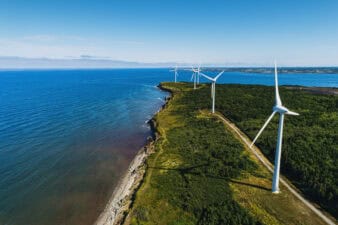Enbridge (TSX:ENB) is a well-known Canadian high yield stock. For much of the last five years, its yield has been well over 7%. In 2022, when oil prices rallied, the stock’s yield fell below 6.5%, as its stock price climbed. Today, oil prices are falling again, which has pushed Enbridge’s yield back above 7%.
The question is, “Is ENB a buy today?” Certainly, a high yield is always tempting, but on the other hand, oil prices are going down. Shouldn’t this reduction in oil prices hit ENB’s business? In the ensuing paragraphs, I will explore that question and more.
Why Enbridge stock fell
The main reason why Enbridge stock fell over the last few months is because oil prices fell. Enbridge doesn’t sell oil directly – it just transports it – but its clients sell it. When oil prices go down, oil stocks tend to fall in price. Enbridge’s revenue is pretty stable whether the price of oil goes up or down, but it’s grouped in with other oil stocks in sector funds that automatically buy and sell the entire sector together. So, ENB goes down along with other oil stocks even though its own operations aren’t that sensitive to oil prices.
That’s not to say that there’s no relationship between ENB’s profit and oil prices. To the contrary, there may be such a relationship over the extreme long run. Enbridge makes money by “renting” pipeline space to customers; these customers are more likely to need it if their business is thriving. If oil prices are high, Enbridge could get more business. If oil prices go so low that Enbridge’s customers go bankrupt, then ENB will lose business. So, there is possibly a long-term relationship between ENB’s profits and oil prices, but it’s much “slower” and weaker than the relationship between oil production profits and oil prices.
Most recent quarter’s earnings
How is Enbridge doing right now, with oil prices sitting at relative lows?
In its most recent fiscal year, it delivered:
- $5.7 billion in adjusted earnings, up 1.7%.
- $15.5 billion in earnings before interest, tax and depreciation (“EBITDA”), up 10.7%.
- $11 billion in distributable cash flow, up 10%.
- $3.55 in annual dividends, up 3.2%.
Overall, it wasn’t a bad showing. The key metric here according to Enbridge’s management is distributable cash flow (“DCF”). This, they say, is the metric that determines how much dividends they can safely pay. Going by DCF, Enbridge’s payout ratio is 72%, which is pretty safe. Others dispute this, pointing out that Enbridge’s free cash flow (a stricter metric) is not high enough to sustainably pay the dividend. As for me, I’m neutral on this topic, and I don’t own Enbridge shares.
Foolish takeaway
Is Enbridge stock a good buy in March 2023? Overall, my opinion is mixed. I like how Enbridge brings in such stable and reliable revenue, but I don’t like how it pays more in dividends than it takes in in free cash flow. I’m pretty much neutral on it. One thing’s for sure though: if you liked Enbridge a year ago, you should love it now, as it’s cheaper and higher yielding than it was then.









